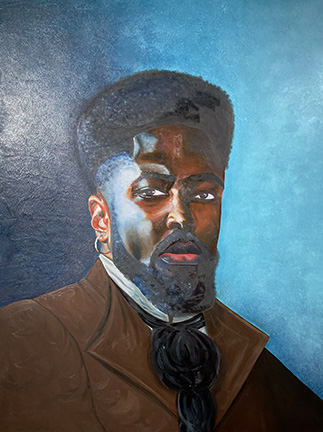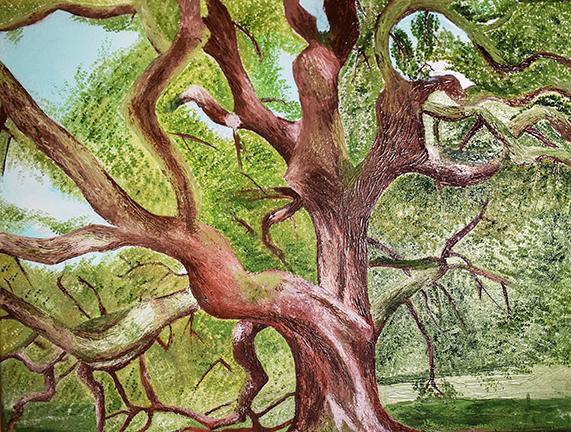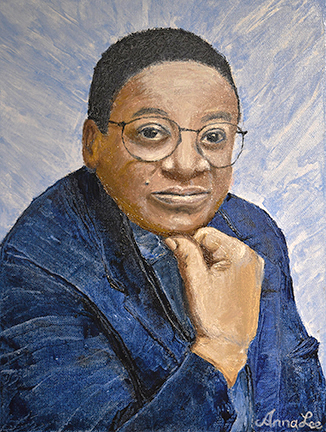Freedom House Exhibition shows the works of NOVA Alexandria Painting Students at Freedom House of Alexandria

Our painting students and the staff and historians of Freedom House of Alexandria collaborated on creating portraits of significant African American community members to examine the African American experience in Alexandria from the 18th century to present day. The Freedom House which was once part of the headquarters for the largest domestic slave trading firm in the United States and now serves as a site of consciousness to ponder a part of our history that is complex and conflicting. We did this to honor prominent African Americans who provided significant contributions to civil liberties and social justice in the United States from the eighteenth century to the present day. Determined will showcase the tremendous courage and accomplishments of Alexandria’s African Americans.
The exhibition, Determined in Alexandria, examines our history and includes artifacts, student portraits, historical information, and statements from the students about what their participation meant to them. The exhibition has been on display for the past two years of a three-year minimum exhibition.
The initiative to partner students with the Freedom House was led by Professor Stacy Slaten, who teaches art at the Alexandria campus, along with former Dean Jimmie McClellan, in collaboration with Freedom House historian Apasrin Suvanasai and curator Michele Longo.
Professor Slaten explains, “The Freedom House project has provided a valuable teaching tool for real-world experience for NOVA’s emerging artist’s and a platform for course discourse on diversity, equity, and inclusion…We are re-writing our future by examining the past.”
The museum sets the scene of Black experience in Alexandria by beginning with Alexandria’s history:
“As a port city, Alexandria had ties to both the transatlantic and domestic slave trades. When European settlers arrived, they used enslaved labor to clear the land that would become Alexandria. Within the city, enslaved men, women, and children labored in warehouses, businesses, and homes. Plantations surrounding the city used enslaved labor for growing tobacco and, later, wheat for flour production. By the end of the 18th century, Alexandria was among the ten busiest ports in the U.S., profiting from exports created using enslaved labor.” (The Freedom House Museum).
The portraits that the students created are oil and acrylic on stretched canvas, with most using a palate knife technique, as opposed to a brush. “That technique,” Professor Slaten explained, “gives the paintings a more contemporary look than most traditional museum portraits by leaving the texture of the mark.”
As a project of the painting class, these painting were not only about drawing and painting in a painterly fashion, but also learning how to create skin tones and color compliments. The students collaborated extensively with historian Apasrin Suvanasai to reference historical documents such as newspapers, written accounts, and photos or prints spanning back to the 1800’s. The students had to discuss skin tones, mix color palettes, and invent the details and colors from the historical accounts or from their perceived imagination if we did not know. Considering the complexities of all the nuanced knowledge the students had to learn, they managed to do it very well, despite being constrained to classes via Zoom during the pandemic.
Professor Stacy Slaten painted one of the portraits to use as teaching example. She took the portrait that had the least amount of information and created an image based off the limited knowledge that Lawrence Day was a part of the group dubbed the Secret Seven by the FBI. No other facts were available. She gave him a persona that reflected a type of secret agent or James Bond reference. She did this to model and demonstrate the process and as an example. Prof. Slaten considers the communal creative projects as part of her professional practice as an artist to effect change in the community. It also lends an experiential learning component to the studio classroom, enhancing student outcomes by engaging the student as a whole person. The student then engages in a real-world problem in the safety of the educational setting.
Everyone did a wonderful job managing the artistic process and learning experience which was impacted by the challenges of the pandemic. Everyone had to create and complete these paintings on zoom instead of being in person!
Lawrence Day (1911 – 2000)
“First Black Magistrate for the City of Alexandria, 1972; Charter member of the Departmental Progressive Club; Member of the Hopkins House Board” (The Freedom House Museum).

Prof. Stacy Slaten reflects on her artistic experience:
Lawrence Day was a part of a group known as “The Secret Seven” dubbed by the FBI. While this group had profound civic influence through sociopolitical activities, not much historical record exists for Lawrence’s clandestine political engagement. It made me think about the service of people unknown, who may impact our lives in ways we will never know. I wanted to give him an air of mystique, with a sense of humor and intelligent gaze, a debonair man so to say.”
In addition, the Freedom House used to house a trading firm that trafficked thousands of Black men, women, and children from 1828-1861. It was converted to a museum dedicated to honoring and understanding “the lives and experiences of enslaved and free Black people who lived in and were trafficked through Alexandria.”
“Determined showcases the tremendous courage and accomplishments of Alexandria’s African Americans,” said Professor Slaten. “We hope that by highlighting the past through these portraits and addressing past trauma, we change the future.”
There are many more display gems within this exhibit that help Illustrate the achievements of these historic Alexandria residents and their impact on countless lives, neighborhoods, and the City of Alexandria. Below are just a portion of the exhibit experience for those featured.
“Black Americans built the foundations of our country while they were fighting for citizenship and rights. Despite enslavement, institutional racism, oppression, and injustice, members of Alexandria’s African American community succeeded in the building families and a network whose legacy shaped today’s City of Alexandria” (The Freedom House Museum).
Their stories can be seen and read, while highlighted in this exhibit, through the coming year.

Throughout the exhibit amazing Americans who fought to make change are visually remembered by paintings from Northern Virginia Community College students.
Eudora N. Lyles 1918- 2000
The exhibit displays Eudora’s efforts toward fair and equal housing in historically black neighborhoods. The Freedom House explains, “After witnessing her parents lose their home to eminent domain, local activist Eudora Lyles made fair housing her life’s mission.”

Student Artist Caitlyn Raymond writes, that Eudora was, “Gentle but resilient. In my painting I wanted her skin tone to be warm to show the gentleness, but I layered it with bold purples to show an authority about her. This piece was 97% done using a pallet knife technique. I feel that the rough texture represents hardships but looking at it all as one piece shows the beauty and uniqueness that comes from it.”
Other 1950s civil rights icons, include some of the following men who were part of The Secret Seven, “who collectively tackled segregation and racial injustice within the city during the 1950s and 1960’s. They used their positions as politicians, church officials, business owners, and civic leaders to strategically improve opportunities in housing, jobs, and education for the African American community” (The Freedom House Museum).
The Exhibit also celebrates more of those who served the community at large.
Dominick Barecroft 1762-1830,
Dominick, “…was the first African American shopkeeper in Alexandria. His success allowed him to purchase his wife Esther’s freedom in 1804. By 1818, he purchased property at 315 Cameron Street for use as his tavern and growing family’s home” (The Freedom House Museum).

Student Artist, Nicole Mullings-Pettus, who painted the portrait of Mr. Barecroft, shared reflections on her process, “I had to learn a lot about Dominick Barecroft before I could even know where to start painting his likeness. There are no paintings of him from his time. I only had a written description…. After learning his history and hearing nothing but greatness, I saw Dominick as a Black man that overcame his obstacles and achieved his dreams. I wanted to paint him in his prime years to showcase his dignity and his pride.”
The Emancipation Tree
“Mary S. Peake, 1823-1862, became the first African American paid to teach those who came to Fort Monroe to escape slavery” (The Freedom House Museum).
The museum explains, Peak’s teaching was done under what became known as The Emancipation Tree. Here, children of freed men were taught by day and adults during the evening. It was in this very space, under the tree’s canopy that former slaves were able to be present for the reading of President Lincoln’s Emancipation proclamation.

Student artist, Marwah Ashna, reflects on the Emancipation Oak tree at Hampton University: “One of the greatest pieces of African American history lives with us today, The Emancipation Oak tree. Born from a single seed and now it stands 16 feet around with a 100-foot-wide canopy that soars 50 feet. I find it as the perfect symbol of freedom, strength, and beauty…. This tree is not only an attention grabber, but it is a reminder to my Black brothers and sisters of their freedom: the freedom of speech, and opportunity.”
Dr. Albert Johnson 1866-1949
Another determined Alexandria Citizen was Dr. Albert Johnson, who, “was the first African American physician to practice in Alexandria. segregation prevented him from seeing patients at the hospital. Instead, he opened a private practice in his home in 1894” (The Freedom House Museum).

Student artist and painter, Jerusalem Amdemichael reflects on her painting process, “I decided to paint Dr. Albert Johnson because he looked like he could be an uncle of mine… it was great to show respect and pay homage to these people who played a great role locally and throughout the rest of the society. To have this exhibit to show how African Americans helped move society forward is important because what they do is often overshadowed. I feel honored to help highlight Dr. Johnson’s importance to this community and the success he achieved during a time where it was difficult.”
F.H.M Murray 1859-1950.

Anna Lee, another of our student artists, who also created an original painting for this exhibition expounds on F.H.M. Murray, as “an intellectual, civil rights activist and journalist in Washington, D.C. and Alexandria, VA,” who, “was active in promoting Black homeownership, opposing Jim Crow laws and lynching. He supported positive representation of African Americans in public art. He was an art historian active in the early 20th century who published a series of works on African Americans portrayed in art. Freeman Murray was a forgotten pioneer for civil justice.”
Reverend Andrew W. Adkins 1884-1963,
“Reverend Andrew W. Adkins led the Alfred Street Baptist Church for 43 years (1920-1963). Not only a pastor, Rev. Adkins was also a teacher at Parker-Gray School, the first coeducational school for African American children in Alexandria” (The Freedom House Museum).

Student Artist Sue Williams reflects on how he inspired her portrait of him: “He has very considerate and discerning eyes…. Seeing from the black and white picture, I could only imagine what it would have been like to be pastor where there are limited resources available yet required him his time and wisdom to do his calling. I felt certain compassion in my heart and respect although I never knew about him.”
You can read more on Reverend Adkins and on his legacy within the educational community within the exhibition tour.
Annie B. Rose 1893-1989
“Rose’s activism saved the historic 19th century Alfred Street Baptist Church building and led to the creation of the Alexandria Society for the Preservation of Black Heritage” (The Freedom House Museum).
Student artist, Rose Bridwell, effuses, “Annie Beatrice Bailey-Rose was a strong Black woman with courage and compassion to do all that she could to make a white supremacist world a better place. She is described as a ‘gentle, self- effacing woman of deep religious conviction and bone deep conviction to social justice.’ She used her voice, education, talents, money, and time to speak for those who needed her voice…. I humbly pledged to her a commitment to stop complaining about racism and start taking ACTIONS to help those who need my voice and gifts.”
Thanks to the Alexandria Black History Museum, the exhibit shows more of Annie’s life, including her typewriter, an image of Annie sharing the history of, what is now The Freedom House Museum and more detailed information about her impact within the community.
Ferdinand T. Day (1918 – 2015),
Ferdinand Day was the “first black Chairperson for the Alexandria School Board; Member of the Hopkins House Board and Chairman of the Durant Civic Associations Housing Committee” (The Freedom House Museum). Painting by Lucia Lecce.

Father John Davis (1907 –1990),
John Davis was Pastor of Meade Memorial Episcopal Church, 1959-1971.

Artist, James Davenport speaks about his process: “This was my first time using the pallet knife and with that came challenges, but also a personality in its technique. In deciding what colors to use there was a balance, looking at tone from a black and white image and extrapolating from there. The colors would need to come close to representing a life like skin, but remain faithful to the original image… I feel fortunate to be able to take part in the preservation of Father John Davis’s image.”
Melvin Miller (1931 – 2015).
Melvin was a, “civil rights lawyer from 1958-1962; President of the Alexandria chapter of the NAACP and Urban League; Member of Alexandria School Board from 1986-1993” (The Freedom House Museum).

Artist Nicole Mullings-Pettus reflects on her work saying, “I feel that this painting best describes Mr. Miller’s character. He was a man that used his knowledge to help others out of hard situations and with that he spread joy and hope within his community, and I feel that the yellow and his humble smile reflects that.”
Nelson Greene Sr. (1914 –2014),

Nelson Green was the “Funeral Director of Greene Funeral Home; Member of Board of Commissioners of the Alexandria Redevelopment and Housing Authority from 1966-1969; Served on board of Alexandria Chamber of Commerce; Served on Alexandria City Council from 1979-1982; Taught at Parker- Gray School” (The Freedom House).
Col. Marion Johnson (1915-1998)

Marion Johnson was the President of the Seminary Civic Association, Vice President of Alexandria Council on Human Relations, Vice Chairman of Minority Housing Sub-committee, Treasurer of Alexandria Federation of Civic Association, and member of multiple civic associations, including Alexandria Citizen Advisory committee and the Durant Civic Association.
Edward Patterson (1909 – 1979)

“Music teacher and Assistant Principal of Parker-Gray High School; Principal of Parker- Gray Middle School; Director of staff relations and student activities for Alexandria City Public Schools; Member of many Alexandria civic organizations, including the Seminary Civic Association, the NAACP, and the Northern Virginia Urban League Advisory Board” (The Freedom House).
Arthur C. Dawkins 1935-Present

Student Artist Anna Lee writes, “From modest beginnings, he worked his way to the top of his profession as an educator, a teacher, and a free-lance jazz musician. Along the way, he successfully negotiated the transition from segregation to integration, and pointed out the way for others to follow. He will be remembered for touching individuals more than advocating before groups because that is the way that he worked–one individual, one student at a time, and without ever drawing attention to himself.”
In his capacity as a freelance musician, Arthur, “broke racial barriers while performing for the National Symphony Orchestra and the Smithsonian Jazz Masterworks Orchestra. He taught, mentored, and performed at Howard, and through D.C., for over 30 years” (The Freedom House).
How to see the exhibit:
The Freedom House is located at 1315 Duke St, Alexandria, VA 22314. (703) 746-4702
- Timed entry will be every 15 minutes during our hours of operations: Thursday & Friday 11 a.m. – 4 p.m., Saturday 11 a.m. – 5 p.m., Sunday & Monday 1 – 5 p.m.
- Tickets are currently available through the Alexandria Shop.
- As a reminder – if you are a City of Alexandria resident – you automatically receive free admission!
Thank you for your support in creating the “Determined Alexandria” portion of our exhibit at the Freedom House Museum.
NOVA Student Participants:
Fiza Batool, Jerusalem Amdemichael, Eliana Harvey, Soon Young Williams, Rose Bridwell, Anna Lee, Marwah Ashna, Debbie Robison, Lucia Lecce, Nicole Mullings-Pettus, Hatta Omar, James Davenport, Caitlyn Raymond—— with Prof. Stacy Slaten.


